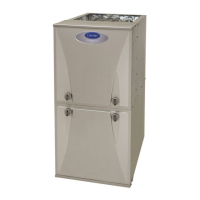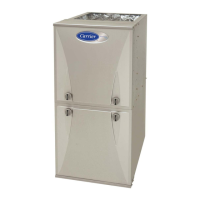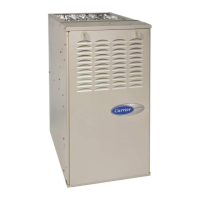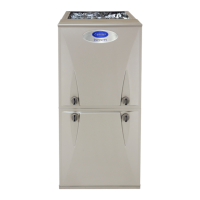PG92MSA: Installation, Start-up, Operating and Service and Maintenance Instructions
Manufacturer reserves the right to change, at any time, specifications and designs without notice and without obligations.
40
A13110
Table 15 – Deductions from Maximum Equivalent Vent Length - Ft. (M)
1. Use only the smallest diameter pipe possible for venting. Over-sizing may cause flame disturbance or excessive vent terminal icing or freeze-up.
2. NA - Not allowed. Pressure switch will not close, or flame disturbance may result.
3. Vent sizing for Canadian installations over 4500 ft. (1370 M) above sea level are subject to acceptance by the local authorities having jurisdiction.
4. Size both the combustion air and vent pipe independently, then use the larger size for both pipes.
5. Assume the two 45_ elbows equal one 90_ elbow. Wide radius elbows are desirable and may be required in some cases.
6. Elbow and pipe sections within the furnace casing and at the vent termination should not be included in vent length or elbow count.
7. The minimum pipe length is 5 ft. (2 M) linear feet (meters) for all applications.
8. Use 3-in. (76 mm) diameter vent termination kit for installations requiring 4-in. (102 mm) diameter pipe.
9. A running Tee in the Combustion Air Pipe adds 0 ft. to the TEVL of the vent length.
Combustion Air and Vent Piping Insulation
Guidelines
NOTE: Use closed cell, neoprene insulation or equivalent.
The vent pipe may pass through unconditioned areas. The amount of
exposed pipe allowed is shown in Table 16.
1. Using winter design temperature (used in load calculations), find
appropriate temperature for your application and furnace model.
2. Determine the amount of total and exposed vent pipe.
3. Determine required insulation thickness for exposed pipe length(s).
4. When combustion air inlet piping is installed above a suspended
ceiling, the pipe MUST be insulated with moisture resistant
insulation such as Armaflex or other equivalent type of insulation.
5. Insulate combustion air inlet piping when run in warm, humid
spaces.
6. Install the insulation per the insulation manufacturer’s installation
instructions.
NOTE: Pipe length (ft. / M) specified for maximum pipe lengths located
in unconditioned spaces cannot exceed total allowable pipe length as
calculated from Table 14.
Configure the Furnace
Near Furnace Vent Connections
Offsets in the vertical portion of the vent pipe should be made with 45
deg. elbows instead of 90 deg. elbows. Short horizontal runs of vent pipe
are difficult to pitch correctly and may trap water in the vent pipe.
Trapped water in the vent pipe may result in nuisance pressure switch
tripping.
Install the Vent and Combustion Air Pipes
With the furnace installed in the required position, remove the desired
knockouts from the casing. It will be necessary to remove one knockout
for the vent pipe and the other knockout for the combustion air
connection. See Fig. 15.
Use a flat blade screwdriver and tap on the knockout on opposite sides,
where the knockout meets the casing. Fold the knockout down with duct
pliers and work the knockout back and forth until it is removed. Trim
any excess metal from the knockout with tin snips.
The vent elbow can be rotated to the required location on the casing if
necessary. See Fig. 53. To rotate the vent elbow:
Pipe Diameter (in): 1-1/2 2 2-1/2 3 4
Mitered 90º Elbow
8 (2.4) 8 (2.4) 8 (2.4) 8 (2.4) 8 (2.4)
Medium Radius 90º Elbow
5 (1.5) 5 (1.5) 5 (1.5) 5 (1.5) 5 (1.5)
Long Radius 90º Elbow
3 (0.9) 3 (0.9) 3 (0.9) 3 (0.9) 3 (0.9)
Mitered 45º Elbow
4 (1.2) 4 (1.2) 4 (1.2) 4 (1.2) 4 (1.2)
Medium Radius 45º Elbow
2.5 (0.8) 2.5 (0.8) 2.5 (0.8) 2.5 (0.8) 2.5 (0.8)
Long Radius 45º Elbow
1.5 (0.5) 1.5 (0.5) 1.5 (0.5) 1.5 (0.5) 1.5 (0.5)
Tee
16 (4.9) 16 (4.9) 16 (4.9) 16 (4.9) 16 (4.9)
WARNING
!
CARBON MONOXIDE POISONING HAZARD
Failure to follow this warning could result in personal injury or death.
To route the vent pipe and combustion air pipe through the furnace, the
manufacturer supplied kit must be used. Failure to properly seal the
blower compartment from the furnace vestibule could result in the
circulation of carbon monoxide throughout the structure. The vent pipe
and combustion air pipe must be a continuous pipe while passing
through the blower compartment. Seals supplied in this kit must be
installed per the instructions provided. Follow all procedures outlined
in these instructions.

